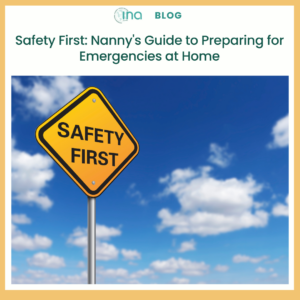 by Katie Brenneman
by Katie Brenneman
As a nanny, you must be constantly alert for health issues and potential emergencies when you’re in charge and the parents are away. Here are some tips for readying yourself for unforeseen issues and how to take action.
Prepare For Potential Health Problems
One of your first responsibilities is ensuring the children stay healthy until you’re off the clock. While random medical emergencies can occur, the children in your care may have particular ailments or vulnerabilities. Ask the parents about any issues you should be aware of so you can prepare accordingly.
A good way to be ready for injuries is to have a well-stocked first aid kit. Ensure it’s filled with the necessities, including gauze, bandages, safety pins, and tweezers, and learn how to use everything effectively. Educate yourself on some first aid basics, like pulling out splinters and making a splint.
It can help to take classes about how to perform life-saving maneuvers, like the Heimlich maneuver and CPR. Stay current on these practices so you can act quickly and be confident in your abilities.
What’s more, be aware of how poor air can impact health. If you notice the kids experiencing respiratory irritation or asthma attacks, consult the parents immediately about possible indoor air pollutants.
Fire Safety Measures
A sudden spark can lead to deadly flames and pose a significant threat, so you and the kids must know how to react in the case of a fire. When teaching the kids about fire safety, explain how one can erupt suddenly, and it can be due to chemicals in a garage, flammable objects near water heaters, or faulty wiring. Everyone must be aware of their surroundings and know when hazards exist.
The most important thing to learn and teach the children is the exit strategy if a fire becomes a reality. You’ll want to have a couple of paths you and the family should use to get out of the house and a meeting place to gather if you get separated. Get the children involved by assigning them a task, like gathering the flashlights. It’s also smart to teach fire survival tactics, like staying low to the ground to avoid smoke inhalation and stopping, dropping, and rolling if they catch fire.
Conduct Emergency Drills
There may also be specific dangers and emergencies where you live for which you should prepare. For instance, many places in the South and Midwest may be susceptible to tornadoes. Practice a drill to get to the lowest level of the house and stay away from windows.
Earthquakes are another potential concern, especially if you live near a major fault line. Teach the children that if an earthquake occurs, they should get under a sturdy desk or table to avoid falling debris. If you happen to be traveling during a quake, the children should know not to exit the car and to stay put until the shaking stops.
Ultimately, the parents should be responsible for creating the emergency plan. However, you may need to provide some guidance. Teach them how to build an emergency kit that includes at least three days’ worth of water and nonperishable food. You or their parents should also teach the children to call the emergency number for your country in case of danger or injury.
Conclusion
Nannies are the adults in charge during many hours of the day, so plans must be in place for as many emergencies as possible. Keep these tips in mind, and you’ll keep yourself and the family safe.
Katie Brenneman is a passionate writer specializing in lifestyle, mental health, education, and fitness-related content. When she isn’t writing, you can find her with her nose buried in a book or hiking with her dog, Charlie. To connect with Katie, you can follow her on Twitter.
